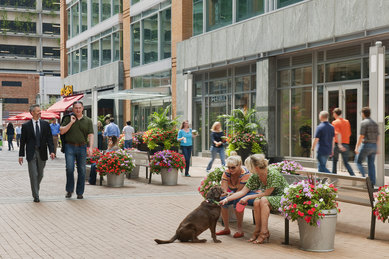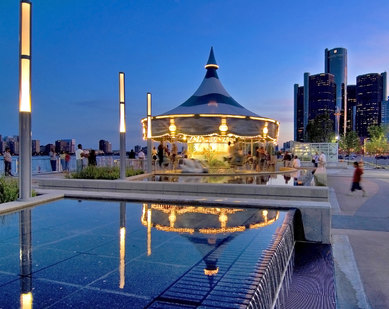Risk, Reward, Result
Four Big Questions Facing Urban Development
In conjunction with the Urban Land Institute 2014 Fall Conference in New York City, SmithGroup hosted a dinner roundtable discussion, themed “Risk, Reward, Result: New Thinking in an Urban State of Mind.” We invited a handful of colleagues and clients for an evening of forward-thinking discussions around development patterns and trends.
These roundtables enable us to hear about trends and challenges directly from the people on the front lines — such as end users of spaces, developers and consultants. Having a broader context for what’s going on makes us better partners and better designers for our clients.
“Forward in all directions!” is often a characteristic of our gatherings, but eventually we focused on four big ideas — questions, really — that were consistently present between the lines. With each question, there was a sense that the key players (developers, end users, and sometimes cities themselves) need to be able to tell better stories to move in the desired direction. And for us, a thoughtful and stronger design narrative helps us create better solutions for difficult challenges.
Where Is the Money?
The money question is top-of-mind, especially for developers. Instead of the money looking for developers, they are being forced to seek it. The money in capital markets is definitely there, but it’s not as easily accessible as it was before 2008. Getting the green light, even in a traditionally solid locale, is no longer a foregone conclusion.
This isn’t a particularly new concept, but it is one that is causing developers to re-evaluate their projects and the way they approach capital providers. They have to be smarter in how they acquire the money. One of the most telling things we heard developers say was that these days, you need a strong rationale to get the money. You need to show what your project is about, why it matters, and how it’s tied into the larger trends in each particular urban market. It makes us at SmithGroupJJR reflect on how we can help developers better tell those stories: how can we marshal our resources to help our clients find the money?
How Will Changing Behavior Patterns Affect Downtowns?
At the same time that there is a flight back to downtown in many major U.S. cities, there is an undercurrent of mobility that makes renting more desirable than owning. We discussed how the younger generation doesn’t have the same home ownership ethic that older generations had imprinted on them. They want to live in the city because of all it has to offer — but they are less enamored with the idea of permanence.
The challenge, then, is how do you establish character in a community where people (literally) aren’t invested in it? How do you create authenticity and permanence when your user group is more transitory? This was an open philosophical question — and while we didn’t find the answers, we did arrive at the fact that perhaps cities need to make a better case for place-making and belonging as a way to become more persuasive about settling down and making long-term contributions. Not just architectural anecdotes, but stories about schools, friendships, neighborhoods, politics, and other things that knit the fabric of place together in people’s imaginations. The trend of increased mobility is one to watch closely and, honestly, it could swing in many different directions.
What Comes After the Town Center?
Once the ideal development, “town centers” have become somewhat stale. That leaves the question: what takes its place? What is unique? How do you leverage the things that people are asking for — like well-designed common space — in a new and special way? People are intentionally choosing the place over the job these days, so it’s not something cities can take for granted.
There is more to this story, however, because we heard that developers also can’t take for granted that they can show up with a plan for development and get it approved. Crowdsourcing and social media have opened the channels of community feedback. In one way, this is good, because people are demanding a voice about what happens in their community (important for establishing that feel of “place”). But the downside is that the input slows everything down, and can even discourage development — especially bold risks. The group talked a great deal about how some cities seem to be managing this balance. For example, developers in New York City are building 10,000 affordable units over the next five years, because that base is needed to keep the city alive. How did they do that? How are those developers able to stay bold and convince stakeholders to take risks — and can smaller cities around the country learn from their process? Some dinner guests from Michigan shared the success they’ve been having with creating a sustainable Main Street and right-sizing the city services. These success stories need to be shared and emulated.
What Do We Do About Our Infrastructure?
There were several threads to the infrastructure conversation. First, the infrastructure in the U.S. is falling apart, and we need $3.6 trillion in investment to repair and upgrade it. We are 30 years behind in updating some systems, and more pressure is being put on developers to include these public system upgrades as urban sites are redeveloped.
At the same time, some of the recent investments in light rail infrastructure that seemed so promising just aren’t living up to the original vision. For example, our guests from Phoenix discussed that their new light rail has not generated the expected ridership and support, and that’s put the brakes on much-anticipated development along the transit corridor. This was echoed in Washington, DC, where funding for light rail was recently reduced, and in Arlington, Virginia, where two light rail lines were just canceled. Cities around the country are wrestling with the same development challenges. Perhaps it’s another example of needing better stories to compel people to take mass transit.
Our goal at SmithGroup is to keep our antenna pointed toward these issues, to hear what others are saying, to offer our thoughts, and — when it’s pertinent — to share our experiences and the possible answers we find along the way.

